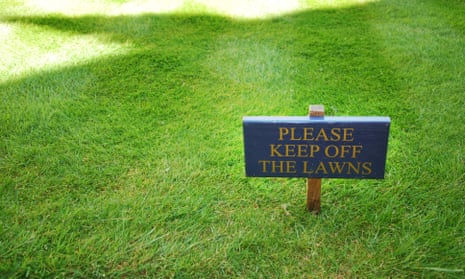As contenders for the 12th Britain’s Best Lawn competition will know, with a great lawn comes great responsibility. Despite the fact that the winner receives a lithium-ion-battery, self-propelled lawnmower (far more eco than a petrol version), lawn-keeping typically involves a shed-load of pesticides and herbicides.
Turf conspiracy theorists insist the manicured lawn is a post-Second World War construct. Corporations in search of a new consumer for their patented chemicals, created an urgent need for manicured grass – the perfect home for their fertilisers and herbicides.
In the US, golf-green lawns remain big business. A 2014 report found that urban streams (natural waterways running through heavily populated areas) were dangerously polluted from pesticides linked to lawncare products. And as the nesting season begins for sea turtles on the coast of Florida, turtle researchers are looking at the “run off” (movement of contaminants across the soil surface) from lawns of beachfront properties on vulnerable loggerhead turtle populations.
But is the worm turning? In 2011, New Jersey introduced fertiliser-content standards, restricting the use of phosphorous and nitrogen. During the drought of 2015, the California Assembly had to reverse legislation that fined citizens for letting their lawns go brown. The Mormon temple in LA led the way by letting its famous lawn dry out in the sun.
Instead of slavishly tending a lawn, why not cut it in half and add plants that are ecologically useful? Or turn your turf into eco, mixing grass with wildflowers and clover (both support many other species)? Those who’ve followed this route say they feel liberated.
The big picture: mega dumps in Sri Lanka

Another month, and another tragedy caused by mega dumps. In April a 300ft garbage mountain collapsed in Meethotamulla, in Sri Lanka, killing at least 30 people, including many children. This follows the landslide at a rubbish dump in the Ethiopian capital Addis Ababa the month before, which killed at least 115 people. How many more until something changes?
Well dressed: Horni eco underwear

Eco undies tend to have a humorous approach to environmental issues, so it was only a matter of time before someone would launch Hornï (an anagram of ‘rhino’), an ethical underwear company dedicated to raising funds for wildlife conservation. The launch collection offers three styles of men’s underwear and limited edition of ladies’ boxer shorts (the full women’s line will be available at the end of the year). More surprising is that the Horni brand (the ‘i’ has been chosen at the end rather than a ‘y’ to make the brand ‘memorable but not offensive’) is the brainchild of Al Jazeera anchor man Riz Khan. He became determined to act after covering stories of rhino poaching in Africa and has swapped the news desk for a partnership with Save the Rhino International. Who knows, perhaps Huw Edwards has a range of species-saving boxers in the pipeline, too. Boxer briefs, £20 horniunderwear.com
Email Lucy at lucy.siegle@observer.co.uk or follow her on Twitter @lucysiegle

Comments (…)
Sign in or create your Guardian account to join the discussion